Pondscaping Part One
First, let's talk about limestone. Clark County, Ohio sits on a limestone foundation that not only provides our bedrock, but also contributes to countless chunks of limestone working their way up through the soil. Dig a hole anywhere in Clark County, and you'll pull out at least one limestone chunk. 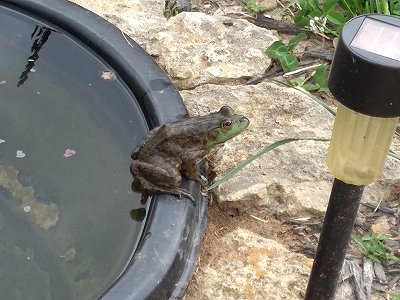
When I installed our MacCourt "Grand Cayman" pond in 2019, I surrounded it with limestone chunks sitting in gravel, as you can see in this closeup of one of our pond's denizens, taken in April, 2022.
As decent as it looks all winter long, keeping that look is almost impossible in the spring and summer. There is a constant influx of weeds, as you'll see in the next photo down.
But that's not the only problem that led to the work described in this article.
Our pond is level (mostly), but the yard is not. Dirt has washed away from the lower side, exposing the lip of the pond by 4-6".
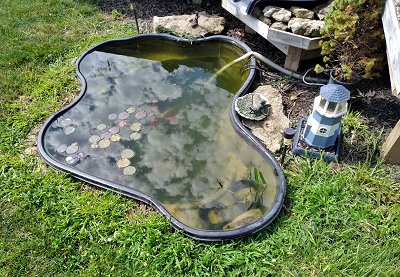 You'll notice that the pond casts a nice shadow on the right side of the photo. There, the dirt has washed away in the two-and-a-half years since I installed the pond. It's not obvious, but our yard drops an inch every twenty inches, and the dirt I mounded up when I installed the pond has gradually gone down the hill. You'll notice that the pond casts a nice shadow on the right side of the photo. There, the dirt has washed away in the two-and-a-half years since I installed the pond. It's not obvious, but our yard drops an inch every twenty inches, and the dirt I mounded up when I installed the pond has gradually gone down the hill.
How to stop the erosion and the weeds? I considered many options, including building a sort of "wooden sidewalk" around part of the pond.
Then a fellow garden railroader announced that he had a big pile of rocks he didn't need any more. I decided to outline the pond with a row or two of rocks set in concrete and topped with sand mix. Not exactly a walkway, much less a mini-plaza, just a way to reduce maintenance and improve the appearance around the pond.
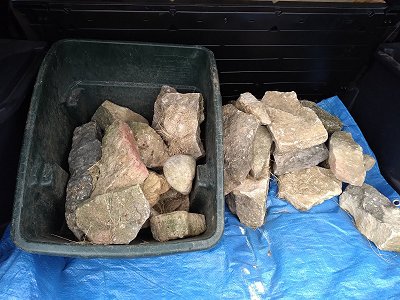 The rocks were mostly limestone chunks, something that I'm quite familiar with, having dug up many dozens on our own properties - often because frost heave had popped them up enough to damage my mower blades. I have used them to make "hills" on both of our railroads. The rocks were mostly limestone chunks, something that I'm quite familiar with, having dug up many dozens on our own properties - often because frost heave had popped them up enough to damage my mower blades. I have used them to make "hills" on both of our railroads.
I started getting a load of rocks every time I went near his house, loading only what I felt my shocks could handle safely. I think I've made five trips now.
Before I started installing the rocks, I screwed a bit of corrugated steel to the framing behind the waterfall. This isn't something I would have done when I was starting out. But I used corrugated steel to provide a rustic-looking "background" to the middle layer of the railroad, and - as it turned out - the reflections made the waterfall on that level look quite dramatic after dark. (I really don't mind the waterfall and pond looking unprototypically colorful after dark, and neither do my visitors.)
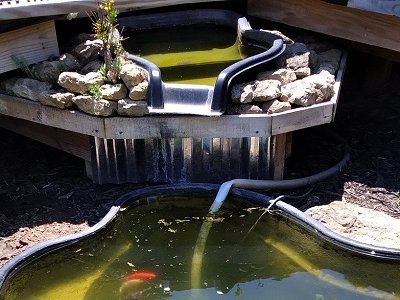 Since I had one piece left that was about the right size, I screwed it in place before I started installing the rocks. I just about had to stand on my head to do so. I also had to predrill the holes, since there was no way I could hold the screw and the screwdriver at the right angle at the same time. Since I had one piece left that was about the right size, I screwed it in place before I started installing the rocks. I just about had to stand on my head to do so. I also had to predrill the holes, since there was no way I could hold the screw and the screwdriver at the right angle at the same time.
Because of the angle, once the rocks went in place, you would never notice the steel during the daytime, but during the night it will add some very nice reflections. In addition, I plan to skirt that part of the railroad eventually, and I knew it would be easier to do this before I installed the rocks.
Then I got out the sand mix. There was going to be crack-resistant concrete under the stones and sand mix between them, but Lowes didn't have crack-resistant concrete, so I just bought extra sand mix.
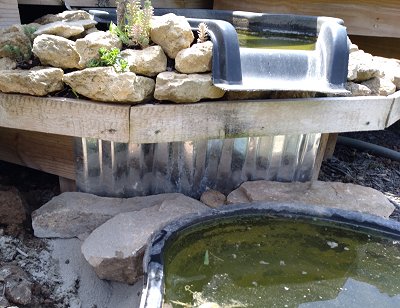 I started on the end of the pond that I knew would be hardest to reach. I started on the end of the pond that I knew would be hardest to reach.
I also knew no one would be walking there, so I took a sort of short cut. I dug down a little so there would be at least a couple inches of of the sand mix underneath the stones.
Then I poured sand mix a couple inches deep, then set stones in it so that the top of the stones would be the same height as the edge of the pond. (Yes, I know, folks who buy "flat stones" and lay the stones over the edge of the pond, so you can't see the black line. But I didn't have enough flat stones for that purpose, and didn't want to go buy a bunch.)
The photo to the right shows the first few stones I set in the sand mix. Then I soaked everything down with a gentle spray, hopefully giving the sand mix "foundation" enough moisture to start setting. (I've done this before and it generally works.)
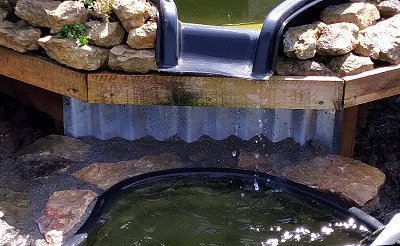 Then I poured sand mix over the stones and brushed it into the cracks between them. Then I poured sand mix over the stones and brushed it into the cracks between them.
Finally, I soaked down the whole section again, to start the "mortar lines" of sand mix setting.
After the soaking, I used the "jet" setting on my hose to blow the loose sand off the top of the stones. The photo to the right shows the first few stones after the sand mix has been brushed into the cracks, wet down thoroughly, then blown off the top of the stones.
For the next parts of the project, I incorporated two large stones that had come from our yard as well as a bunch from my friend's rock pile.
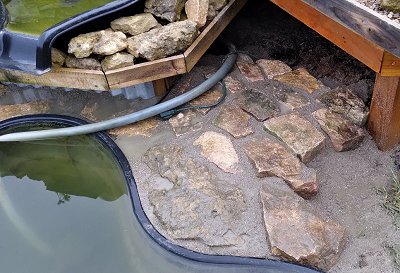 The photo to the right shows one of those stones embedded in the sand mix along with several other stones. In the photo, I had just finished soaking down the sand mix and blowing the sand off the top of the stones. The photo to the right shows one of those stones embedded in the sand mix along with several other stones. In the photo, I had just finished soaking down the sand mix and blowing the sand off the top of the stones.
I made a point of getting the sand mix deep into the "crack" between the stone and the edge of the vinyl pond liner. The "mortar line" will almost certainly crack there next winter when the pond freezes, but it should still keep anything from rooting deeply.
What you can't tell from the photo is that most of the stones are between 4" and 6" high, and the sand mix is deeper or shallower to compensate. All of this is to make up for the 6" gap between the edge of the pond and the ground level at that point.
Since the sand mix under the stones is sitting mostly on undisturbed clay, I expect the little "plaza" to stay stable indefinitely. 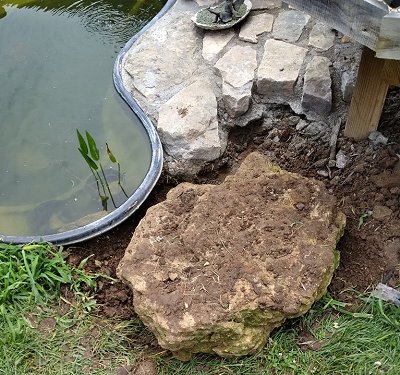
Incorporating Natural Elements - That's a fancy name for admitting that we had an ugly ~100-pound limestone boulder that came out of the yard during a minor regrade, and which has been in our way for five years.
Although it's not exactly pretty, it is deep enough to match the distance between the lip of the pond liner and the ground. So I dug out a place for it, flopped it over and used a crowbar and shovel to skootch it into place.
Actually, I had to do that twice since the first excavation wasn't deep enough for the rock to sit level. All told, just getting this rock in place took me two hours in 85F weather, high humidity, and bright sunshine. Ugh!
In this photo, it's still dirty from being flopped over. It doesn't look that much better hosed off. Maybe I can claim I used it to help with the "rustic" look of the project. 
That's one rock I'm confident will stay in place if people walk on it.
After skootching the boulder into place, I poured a bunch of sand mix around it and set a few smaller stones to fill the gaps that were left.
Most of the stones remaining at this point were 4" or less deep. The sand mix under them is as much as 4" deep so they'd level up with the rest.
In this photo I have yet to soak down the sand base or pour sand mix between the stones to make my "mortar lines." I wanted to hold off until I got the next section done while everything was still dry.
Starting the North Side - Working my way around, I dug a shallow trench along the north side of the pond (below left).
Next, I poured a thick layer of sand mix into it, then played "Tetris" with a bunch more rocks (above right). By this point, I was down to using some rocks that were only a couple inches thick, so the sand mix underneath some of them is pretty thick.
I did try to use thicker rocks along the edge to reduce the chance of them rolling outward if people step on them from a funny angle. When I'm all done, I plan to backfill around the stones with the clay I displaced for this project, hopefully adding some additional stability.
East Side Considerations - I took the photo below when I was "done for the night," expecting to continue the project the next day. Ooops. Unscheduled rainstorms prevented further progress for a few days.
But you can see that a little less than half remains to be done. What you can't see is that the ground there is almost the level of the pond edge, so I should be able to use those thinner rocks without pouring deep layers of sand mix.
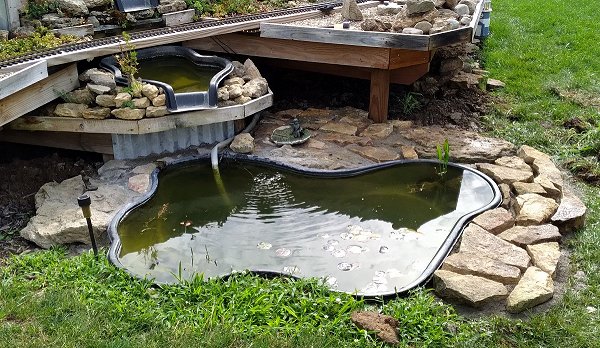
If, when I'm done with the east side, I have enough rocks and time, I may add more rocks to the left, similar to what I did in the other corner. Otherwise there might be a couple more bags of mulch in my future.
Another project I'm considering for this summer is using pressure-treated fencing boards to "skirt" the east end of the lower platform, mostly just to dress it up a little.
A neighbor asked me yesterday if I was still planning on making the railroad bigger (plans that got thwarted when lumber became unavailable in 2020). I told her that this year I will probably focus on making what I have better.
Keep in Touch
If you're headed toward or past Springfield, Ohio, please let me know, and I'll see if we can work out a quick visit.
Finally, please let us know about your ongoing projects. Ask questions, send corrections, suggest article ideas, send photos, whatever you think will help you or your fellow railroaders. In the meantime, enjoy your trains, and especially enjoy any time you have with your family in the coming weeks,
Paul Race
FamilyGardenTrains.com
Return to Family Garden Trains' Home Page - The home page with links to all the other stuff, including design guidelines, construction techniques, structure tips, free graphics, and more.
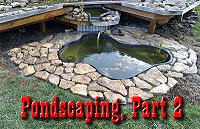 Proceed to "Pondscaping, Part 2" - Circling the rest ot the pond with stones, more comments about using sand mix and related topics. Proceed to "Pondscaping, Part 2" - Circling the rest ot the pond with stones, more comments about using sand mix and related topics.
Click on the photo to see our status as of mid-July, 2022.
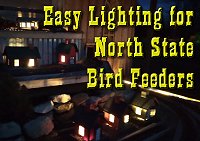 Return to "Easy Lighting for North States Bird Feeders" - After I put my model buildings away for the winter, I brought out the North States bird feeders I use to keep my railroad from looking naked all winter long. Since I had wired several sections of my railroad for lighting, I went ahead and put lighting in my bird feeders as well. Return to "Easy Lighting for North States Bird Feeders" - After I put my model buildings away for the winter, I brought out the North States bird feeders I use to keep my railroad from looking naked all winter long. Since I had wired several sections of my railroad for lighting, I went ahead and put lighting in my bird feeders as well.
Click on the photo to see our status as of December, 2021.
 Return to "Preparing for 2021's Christmas Train Day." - In preparation for our annual Christmas-themed open railway, I ran lighting to some of our buildings, installed rope lighting on one section, and chose appropriate rolling stock. I also lit a bunch of our dwarf conifers and ran colored light strands that would brighten up our waterfall after dark. Return to "Preparing for 2021's Christmas Train Day." - In preparation for our annual Christmas-themed open railway, I ran lighting to some of our buildings, installed rope lighting on one section, and chose appropriate rolling stock. I also lit a bunch of our dwarf conifers and ran colored light strands that would brighten up our waterfall after dark.
Click on the photo to see our status as of early November, 2021.
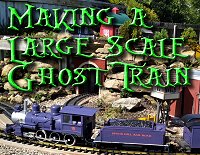 Return to "Making a Large Scale Ghost Train" - In preparation for an October open railway, I repainted and relabeled decrepit Bachmann Big Hauler pieces to create a one-of-a-kind Halloween train. Materials included purple spray paint and vinyl lettering I created on my Cricut. I added "ghost" passengers made from cheap Asian seated figures painted with glow-in-the-dark paint. Return to "Making a Large Scale Ghost Train" - In preparation for an October open railway, I repainted and relabeled decrepit Bachmann Big Hauler pieces to create a one-of-a-kind Halloween train. Materials included purple spray paint and vinyl lettering I created on my Cricut. I added "ghost" passengers made from cheap Asian seated figures painted with glow-in-the-dark paint.
Click on the photo to see our status as of mid-October, 2021.
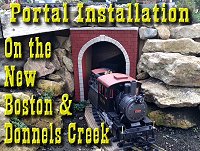 Return to "Portal Installation on the New Boston and Donnels Creek." . We shimmed out the frames for the tunnel entrances to make them more vertical, installed I.S.L.E. portals we had painted previously, and stacked stones around them to camouflage the wooden parts. There's a bit more work to do, but its a big improvement over black holes at each end of the tunnel Return to "Portal Installation on the New Boston and Donnels Creek." . We shimmed out the frames for the tunnel entrances to make them more vertical, installed I.S.L.E. portals we had painted previously, and stacked stones around them to camouflage the wooden parts. There's a bit more work to do, but its a big improvement over black holes at each end of the tunnel
Click on the picture to see our status as of early October, 2021.
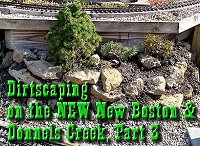 Return to "Dirtscaping on the New Boston and Donnels Creek, Part 3" - Raising 'mini-mountains' near the new tunnels to make them seem more blended into the dirtscape. Lots of rocks moved, and more trees trimmed and planted. Also, we moved our towns into position in preparation for a club meeting at our home. Return to "Dirtscaping on the New Boston and Donnels Creek, Part 3" - Raising 'mini-mountains' near the new tunnels to make them seem more blended into the dirtscape. Lots of rocks moved, and more trees trimmed and planted. Also, we moved our towns into position in preparation for a club meeting at our home.
Click on the photo to see our status as of mid-August, 2021.
 Return to "Tunnel Framing on the New Boston and Donnels Creek, Part 2" - Adding rocks, dirt, and plants to the new tunnel structures. Because I wanted to transplant dwarf and miniature trees to the new "mountains," I had to move a substantial amount of rocks and dirt. But I feel the result will be well worth it, once the groundcovers fill in. Return to "Tunnel Framing on the New Boston and Donnels Creek, Part 2" - Adding rocks, dirt, and plants to the new tunnel structures. Because I wanted to transplant dwarf and miniature trees to the new "mountains," I had to move a substantial amount of rocks and dirt. But I feel the result will be well worth it, once the groundcovers fill in.
Click on the photo to see our status as of late July, 2021.
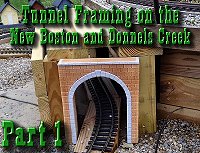 Return to "Tunnel Framing on the New Boston and Donnels Creek, Part 1." We planned and built two wooden boxes that would become the framework for two short tunnels on our raised platform railroad. That effort was made a little more complicated by the fact it was a "retrofit." I hadn't planned for them at first, so getting them in place took some finangling. Return to "Tunnel Framing on the New Boston and Donnels Creek, Part 1." We planned and built two wooden boxes that would become the framework for two short tunnels on our raised platform railroad. That effort was made a little more complicated by the fact it was a "retrofit." I hadn't planned for them at first, so getting them in place took some finangling.
Click on the picture to see our status as of mid-July, 2021.
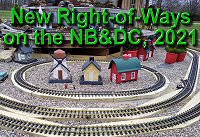 Return to "New Right-of-Ways on the New Boston and Donnels Creek RR" - Adding a loop based on 10'-diameter curves. Includes cutting and installing 2x6 roadbed, bridging the waterfall, and cutting a third passage through the train shed, as well as installing roadbed for two smaller loops. Return to "New Right-of-Ways on the New Boston and Donnels Creek RR" - Adding a loop based on 10'-diameter curves. Includes cutting and installing 2x6 roadbed, bridging the waterfall, and cutting a third passage through the train shed, as well as installing roadbed for two smaller loops.
Click on the picture to see our status as of late March, 2021.
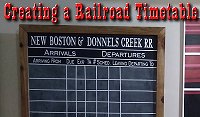 Return to "Creating a Railroad Timetable" - No train station would be complete without a timetable showing arrivals and departures (as well as expected arrivals and departures). We made one with a big piece of underlayment, framed it with scrap lumber, cut lettering for it with a craftcutter, and lined it with striping tape. This one is hinged to a shallow shelving unit that is holding the dvds we sometimes watch while working on projects in our workshop. Return to "Creating a Railroad Timetable" - No train station would be complete without a timetable showing arrivals and departures (as well as expected arrivals and departures). We made one with a big piece of underlayment, framed it with scrap lumber, cut lettering for it with a craftcutter, and lined it with striping tape. This one is hinged to a shallow shelving unit that is holding the dvds we sometimes watch while working on projects in our workshop.
Click on the picture to see our status as of January, 2021.
 Return to "Christmas Preparations and Operations 2020" - A series of families were going to visit during the holiday season (masked and distanced, of course), so we just had to do a little Christmas decorating, and get as many trains running as possible for the kids. This included laying temporary ROWs on the new platform and setting up two Lionel RTP trains for kids to run. Return to "Christmas Preparations and Operations 2020" - A series of families were going to visit during the holiday season (masked and distanced, of course), so we just had to do a little Christmas decorating, and get as many trains running as possible for the kids. This included laying temporary ROWs on the new platform and setting up two Lionel RTP trains for kids to run.
 Return to "Garage to Train Station, Part 2" - continuing to fix up one end of my garage to resemble a Victorian train station interior. I used a digital projector to outline vintage coach details for my windowframes. Then I painted the backgrounds, attached the windowframes, and installed them on the wall. A repro Regulator clock and other details are added. Return to "Garage to Train Station, Part 2" - continuing to fix up one end of my garage to resemble a Victorian train station interior. I used a digital projector to outline vintage coach details for my windowframes. Then I painted the backgrounds, attached the windowframes, and installed them on the wall. A repro Regulator clock and other details are added.
Click on the picture to see our status as of late December, 2020.
 Return to "Garage to Train Station, Part 1" - fixing up one end of my garage to resemble a Victorian train station interior. The initial steps included demolition, patching the ceiling and walls, moving electrical outlets, adding wainscotting and baseboard, and planning for windowframes with painted backgrounds. Return to "Garage to Train Station, Part 1" - fixing up one end of my garage to resemble a Victorian train station interior. The initial steps included demolition, patching the ceiling and walls, moving electrical outlets, adding wainscotting and baseboard, and planning for windowframes with painted backgrounds.
Click on the picture to see our status as of early December, 2020.
 Return to "Westward Expansion, 2020, Part 3" - Thanks to a spate of unusually warm weather in early November, I was able to get the new platform finished, lined with vinyl, and bordered with trim boards to keep the dirt and gravel in place. Return to "Westward Expansion, 2020, Part 3" - Thanks to a spate of unusually warm weather in early November, I was able to get the new platform finished, lined with vinyl, and bordered with trim boards to keep the dirt and gravel in place.
The next "permanent" improvements will wait for now. In the meantime, we will set out buildings and a temporary loop or to entertain visitors between now and Christmas.
Click on the picture to see our status as of mid-November, 2020.
 Return to "Westward Expansion, 2020, Part 2" - We had to be careful leveling the last joists so the frame, decking, and right-of-way would be as level as possible. Fortunately we were able to get enough lumber to get a good start on the frame. Return to "Westward Expansion, 2020, Part 2" - We had to be careful leveling the last joists so the frame, decking, and right-of-way would be as level as possible. Fortunately we were able to get enough lumber to get a good start on the frame.
We also added one last tweak to the frame design to make it easier to extend this platform to its originally planned size, if and when we get a chance to do so.
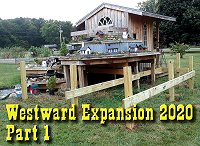 Return to "Westward Expansion, 2020, Part 1" - With a lumber shortage and warm weather running out, we revised our plans for the next addition, bought what decent lumber we could find, dug holes, installed posts, and attached joists. Return to "Westward Expansion, 2020, Part 1" - With a lumber shortage and warm weather running out, we revised our plans for the next addition, bought what decent lumber we could find, dug holes, installed posts, and attached joists.
We were hoping to get the lumber we need to finish the platform before cold weather set in. Click on the link to see our status as of late September, 2020.
 Return to "Train Storage Solutions, 2020" - Using periods of cold weather to get things sorted in the garage, including shelf building and tips for schlepping trains from storage to the tracks. Return to "Train Storage Solutions, 2020" - Using periods of cold weather to get things sorted in the garage, including shelf building and tips for schlepping trains from storage to the tracks.
Click on the following link to see our status as of late January, 2020.
https://familygardentrains.com/newbost/20_1_19_shelves/shelves.htm
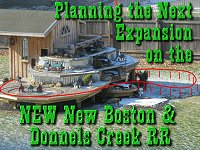 Return to "Expansion Planning, 2020" - Three years after starting a garden railroad in our new home, we are trying to figure out the best way to finish the last loop of our raised platform railroad. How to make room for 10'-diameter curves and more towns and industries, but still keeping things manageable requires some thinking and rethinking. Return to "Expansion Planning, 2020" - Three years after starting a garden railroad in our new home, we are trying to figure out the best way to finish the last loop of our raised platform railroad. How to make room for 10'-diameter curves and more towns and industries, but still keeping things manageable requires some thinking and rethinking.
Click on the photo to see the options we were reviewing for the next and last expansion.
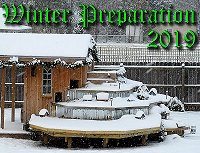 Return to "Winter Preparation, 2019" - After the big open railroad event, we try to prepare the railroad for the cold months, including populating the railroad with North States bird feeders so it doesn't look empty, adding an air pump and bubblers to the pond, and more. Return to "Winter Preparation, 2019" - After the big open railroad event, we try to prepare the railroad for the cold months, including populating the railroad with North States bird feeders so it doesn't look empty, adding an air pump and bubblers to the pond, and more.
Click on the following link to see our status as of early December, 2019.
https://familygardentrains.com/newbost/19_11_24_winter_prep/19_11_24_winter_prep.htm
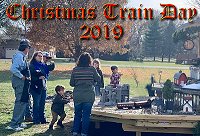 Return to "Christmas Train Day, 2019" - Three years after starting a garden railroad in our new home, we host another Christmas-themed open railroad, giving many families a jump start on Christmas celebrations and sharing the experience of running trains with lots of kids. Return to "Christmas Train Day, 2019" - Three years after starting a garden railroad in our new home, we host another Christmas-themed open railroad, giving many families a jump start on Christmas celebrations and sharing the experience of running trains with lots of kids.
Click on the photo to see a brief record of our busiest weekend in November, 2019.
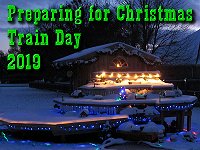 Return to "Preparing for Christmas Train Day 2019" - Wrapping up construction projects for 2019 and getting ready for our annual Christmas-themed open railroad. Includes new lighting and other features, providing a temporary home for a Hogwarts Express train, weather issues, and more. Click to go to article. Return to "Preparing for Christmas Train Day 2019" - Wrapping up construction projects for 2019 and getting ready for our annual Christmas-themed open railroad. Includes new lighting and other features, providing a temporary home for a Hogwarts Express train, weather issues, and more. Click to go to article.
Click on the following link to see our progress of mid-November, 2019.
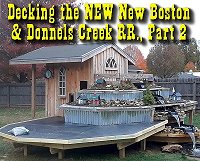 Return to Decking the NEW New Boston and Donnels Creek Part 2 - Getting the next part of the railroad ready to install trains. Includes installing 2"x6" decking, vinyl sheeting, edges to hold back the gravel, and corrugated steel panels. It's not done, but it will give us another place to set up trains for our next Christmas-themed open railroad. Return to Decking the NEW New Boston and Donnels Creek Part 2 - Getting the next part of the railroad ready to install trains. Includes installing 2"x6" decking, vinyl sheeting, edges to hold back the gravel, and corrugated steel panels. It's not done, but it will give us another place to set up trains for our next Christmas-themed open railroad.
Click on the photo to see our status as of late October, 2019.
 Return to "Framing the NEW New Boston and Donnels Creek RR - Part 7" - Installing posts, joists, framing, and decking for the eastern expansion of the NEW New Boston and Donnels Creek. Although this installation was complicated by having to fit into an existing framework, the methods used could work for any raised-platform railroad. Return to "Framing the NEW New Boston and Donnels Creek RR - Part 7" - Installing posts, joists, framing, and decking for the eastern expansion of the NEW New Boston and Donnels Creek. Although this installation was complicated by having to fit into an existing framework, the methods used could work for any raised-platform railroad.
Click on the following link to see our progress of early October, 2019.
 Return to "Planning the NEW New Boston and Donnels Creek RR - Part 5" - Once the major components of the water feature were installed and tested, we decided to add one more bit of railroad proper before our "Christmas Train Day," this November. The addition, about 5'x11', will allow us to put a small train and some scenery closer to eye level for youngsters. Eventually it will be part of the larger plan that will allow us to run our bigger cars and locomotives. Return to "Planning the NEW New Boston and Donnels Creek RR - Part 5" - Once the major components of the water feature were installed and tested, we decided to add one more bit of railroad proper before our "Christmas Train Day," this November. The addition, about 5'x11', will allow us to put a small train and some scenery closer to eye level for youngsters. Eventually it will be part of the larger plan that will allow us to run our bigger cars and locomotives.
Click on the photo to see our plans for the next addition, as of late September, 2019.
 Return to Waterscaping Part 4. - Installing the last connecting pool, so the whole planned waterfall is complete except for dirtscaping and planting. Return to Waterscaping Part 4. - Installing the last connecting pool, so the whole planned waterfall is complete except for dirtscaping and planting.
The process included checking the pump, extending the hoses, rescuing toads, building the platform, trimming the platform, testing the pool's location, etc.
Click the photo to go to the article.
 Return to "Waterscaping, Part 3" - After seven months of crazy long work hours, I finally got some free time to continue working on the railroad. Weather permitting, I often worked all the live-long day. This article describes installing two posts that will eventually support the last connecting pool, then digging the big hole for the in-ground pond, complicated by a three-month drought that turned the ground to concrete. Return to "Waterscaping, Part 3" - After seven months of crazy long work hours, I finally got some free time to continue working on the railroad. Weather permitting, I often worked all the live-long day. This article describes installing two posts that will eventually support the last connecting pool, then digging the big hole for the in-ground pond, complicated by a three-month drought that turned the ground to concrete.
Click on the photo to see our progress as of mid-September, 2019.
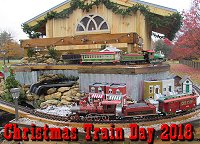 Return to Christmas Train Day, 2018 - After two years without our traditional Christmas Train Day (something we did from 2008 through 2015), we were anxious to get started again, even without a huge right of way to show off. The kids' trains, the extra Thomas railroad, the popcorn popper and two Bachmann Christmas trains got a big workout. And the visiting kids all loved it! Return to Christmas Train Day, 2018 - After two years without our traditional Christmas Train Day (something we did from 2008 through 2015), we were anxious to get started again, even without a huge right of way to show off. The kids' trains, the extra Thomas railroad, the popcorn popper and two Bachmann Christmas trains got a big workout. And the visiting kids all loved it!
Click on the photo to see a lot of last-minute preparations and some photos of the November 10, 2018 event itself.
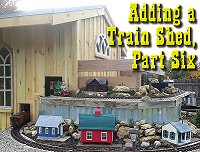 Return to "Adding a Train Shed Part 6" - Installing the board and batten siding on our train shed, installing the windows, installing the trim, testing the "tunnel entrances," and more. Return to "Adding a Train Shed Part 6" - Installing the board and batten siding on our train shed, installing the windows, installing the trim, testing the "tunnel entrances," and more.
By the way, going over lumber receipts in early 2019, I couldn't believe I was still siding the train shed in late October, and managed to have an open railroad in mid-November. It is a little crazy how fast things can go together if you have a deadline and a lot of gift cards.
Click on the photo to see our progress as of late October, 2018.
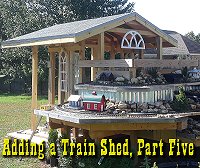 Return to "Adding a Train Shed Part 5" - Planning the doors, walls, and windows of our garden train shed. Return to "Adding a Train Shed Part 5" - Planning the doors, walls, and windows of our garden train shed.
Includes choosing the siding and windows, installing the door, painting the windowframes, and adding crosspieces to support the vertical siding boards.
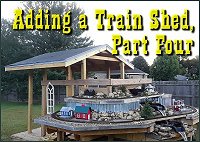 Return to "Adding a Train Shed Part 4" - Choosing and installing underlayment and drip edge to protect the sheathing until I can get the final roof installed. Return to "Adding a Train Shed Part 4" - Choosing and installing underlayment and drip edge to protect the sheathing until I can get the final roof installed.
Now the roof is waterproof enough to get us through the next couple of months at least, maybe more.
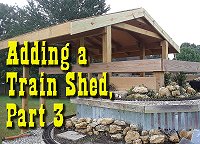 Return to "Adding a Train Shed Part 3" - Adding fascia, sheathing, and end trim to the in-progress train shed. Return to "Adding a Train Shed Part 3" - Adding fascia, sheathing, and end trim to the in-progress train shed.
I thought about bringing in helpers for this part, but a reader commented on how helpful it was to see how one person could do this sort of thing by himself, so I just kept plugging away.
Click on the photo to see our progress as of September 13, 2018
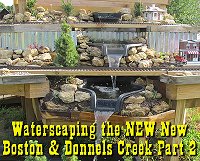 Return to "Waterscaping Part 2" - Getting this year's waterscaping project done (for now at least). Installing and dirtscaping the third level of the waterfall. Installing pump and filter, adding an extra container and modifying the ones we already had installed to keep the water running smoothly. And lots of other tweaking. Includes tips about introducing fish and plants, as well as other information about water features in general that you may find helpful. Return to "Waterscaping Part 2" - Getting this year's waterscaping project done (for now at least). Installing and dirtscaping the third level of the waterfall. Installing pump and filter, adding an extra container and modifying the ones we already had installed to keep the water running smoothly. And lots of other tweaking. Includes tips about introducing fish and plants, as well as other information about water features in general that you may find helpful.
Click on the photo to see our status as of August 5, 2018.
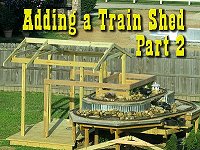 Return to "Adding a Train Shed Part 2" - Adding rafters to the frame of the in-progress train shed. Now it's starting to look like it might actually be a structure and not just a crazy collection of posts. Return to "Adding a Train Shed Part 2" - Adding rafters to the frame of the in-progress train shed. Now it's starting to look like it might actually be a structure and not just a crazy collection of posts.
The way we got the rafters and ridge board up wouldn't work for everybody, but it worked for us, and hopefully will help other folks to "think outside the box" - literally in this case.
Click on the photo to see our progress as of July 14, 2018.
 Return to "Adding a Train Shed Part 1" - What started out as a simple addition of a deck to stand on when putting trains on the track got a little more ambitious when I realized that JUST installing the deck this year would require more work next year. So we framed out what we planned to be a train shed attached to the railroad. If it ever gets finished, I can easily put trains on the track at a moment's notice instead of schlepping them out from the garage. Return to "Adding a Train Shed Part 1" - What started out as a simple addition of a deck to stand on when putting trains on the track got a little more ambitious when I realized that JUST installing the deck this year would require more work next year. So we framed out what we planned to be a train shed attached to the railroad. If it ever gets finished, I can easily put trains on the track at a moment's notice instead of schlepping them out from the garage.
Click on the photo to see our status as of July 9, 2018.
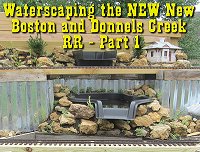 Return to "Waterscaping the NEW New Boston and Donnels Creek Part 1," our article on getting the top two layers of the waterfall on solid footing and getting the third layer framed. After we finish decking and dirtscaping the third layer, we will probably add a washbasin or something for the water to flow into, then add a pump to get the waterfall flowing. No big pond until next year at least - too many other projects. Return to "Waterscaping the NEW New Boston and Donnels Creek Part 1," our article on getting the top two layers of the waterfall on solid footing and getting the third layer framed. After we finish decking and dirtscaping the third layer, we will probably add a washbasin or something for the water to flow into, then add a pump to get the waterfall flowing. No big pond until next year at least - too many other projects.
Click on the photo to see our progress as of June 13, 2018.
 Return to "Dirtscaping the NEW New Boston and Donnels Creek RR, Part 2. - Adding barriers to keep the rocks, dirt, and plants where they're supposed to go, placing platforms and running wiring for buildings, adding rocks, dirt, and plants to the upper level of the railroad. Return to "Dirtscaping the NEW New Boston and Donnels Creek RR, Part 2. - Adding barriers to keep the rocks, dirt, and plants where they're supposed to go, placing platforms and running wiring for buildings, adding rocks, dirt, and plants to the upper level of the railroad.
Click on the photo to see our status as of June 1, 2018.
 Return to "Adding Raised Roadbed to the NEW New Boston and Donnels Creek, Part 2" - Trimming the corners off the roadbed on the upper layer and cutting the pieces that will support the curves on the middle layer. We need to get the upper two tiers of the pond installed before we totally complete this step, so the article doesn't quite show the finished product. You'll see it later as part of other articles. Return to "Adding Raised Roadbed to the NEW New Boston and Donnels Creek, Part 2" - Trimming the corners off the roadbed on the upper layer and cutting the pieces that will support the curves on the middle layer. We need to get the upper two tiers of the pond installed before we totally complete this step, so the article doesn't quite show the finished product. You'll see it later as part of other articles.
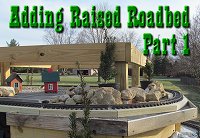 Return to "Adding Raised Roadbed to the NEW New Boston and Donnels Creek RR, Part 1" - Sorting out our priorities for the spring and summer of 2018. There a lot of little chores we really should get done before we start on the next big addition. Click to see our plans as of February 27, 2018. Return to "Adding Raised Roadbed to the NEW New Boston and Donnels Creek RR, Part 1" - Sorting out our priorities for the spring and summer of 2018. There a lot of little chores we really should get done before we start on the next big addition. Click to see our plans as of February 27, 2018.
Click on the photo to see our status as of February 20, 2018
 Return to "2018: Springing into Spring on the NEW New Boston & Donnels Creek RR." - Sorting out our priorities for the spring and summer of 2018. There a lot of little chores we really should get done before we start on the next big addition. Click to see our plans as of February 27, 2018. Return to "2018: Springing into Spring on the NEW New Boston & Donnels Creek RR." - Sorting out our priorities for the spring and summer of 2018. There a lot of little chores we really should get done before we start on the next big addition. Click to see our plans as of February 27, 2018.
Click on the photo to see our status as of February 20, 2018
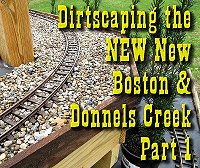 Return to "Dirtscaping the NEW New Boston and Donnels Creek RR, Part 1. - Putting edging around the existing "layers" of the new railroad, and beginning to add gravel and rocks. There were a few test runs, but we got stopped early by bad weather before we could dump the rest of the rocks, gravel, and dirt, much less plant the plants we hoped to get in before snowfall. Return to "Dirtscaping the NEW New Boston and Donnels Creek RR, Part 1. - Putting edging around the existing "layers" of the new railroad, and beginning to add gravel and rocks. There were a few test runs, but we got stopped early by bad weather before we could dump the rest of the rocks, gravel, and dirt, much less plant the plants we hoped to get in before snowfall.
Click on the photo to see our status as of November 21, 2017
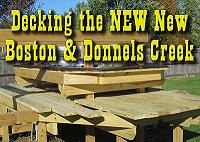 Return to "Decking the NEW New Boston and Donnels Creek RR - Decking the 'middle layer' of our proposed three-tier outdoor railroad. Prepping more track, laying out track and decking to make certain we have measurements correct, installing most of the remaining decking for this layer. Return to "Decking the NEW New Boston and Donnels Creek RR - Decking the 'middle layer' of our proposed three-tier outdoor railroad. Prepping more track, laying out track and decking to make certain we have measurements correct, installing most of the remaining decking for this layer.
Click on the photo to see our status as of October 25, 2017
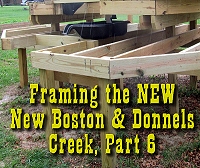 Return to "Framing the NEW New Boston and Donnels Creek RR, Part 6" - Modifying and finishing the framing on the second layer, cantilevering, using R3 track versus all other pre-curved track formats, finalizing the track plan, why painting the track makes old and new track blend better, and more. This will be the last bit of "framing" in 2017, and it worked out well, considering. Return to "Framing the NEW New Boston and Donnels Creek RR, Part 6" - Modifying and finishing the framing on the second layer, cantilevering, using R3 track versus all other pre-curved track formats, finalizing the track plan, why painting the track makes old and new track blend better, and more. This will be the last bit of "framing" in 2017, and it worked out well, considering.
Click on the photo to see our status as of October 15, 2017
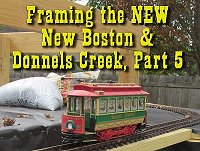 Return to "Framing the NEW New Boston and Donnels Creek RR, Part 5" - Spreading the billboard-sourced vinyl underlayment on the top layer. Prepping used Aristo track for (hopefully) many more years of service. Laying the first loop of track, attaching power wires with spade terminals, and testing conductivity with a Bachmann streetcar. Return to "Framing the NEW New Boston and Donnels Creek RR, Part 5" - Spreading the billboard-sourced vinyl underlayment on the top layer. Prepping used Aristo track for (hopefully) many more years of service. Laying the first loop of track, attaching power wires with spade terminals, and testing conductivity with a Bachmann streetcar.
Click on the photo to see our status as of October, 10, 2017
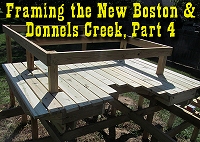 Return to "Framing the NEW New Boston and Donnels Creek RR, Part 4" - Planning and running the decking for the top layer, testing the track plan, checking clearances, prepping used track with new railjoiners, examining the vinyl I ordered to go over the decking, and more. Return to "Framing the NEW New Boston and Donnels Creek RR, Part 4" - Planning and running the decking for the top layer, testing the track plan, checking clearances, prepping used track with new railjoiners, examining the vinyl I ordered to go over the decking, and more.
Click on the photo to see our status as of September 26, 2017
 Return to "Framing the NEW New Boston and Donnels Creek RR, Part 3" -
Getting the frame finished on the top layer, ordering other things I'd need eventually, deciding on materials for the decking on the top layer (at least). Return to "Framing the NEW New Boston and Donnels Creek RR, Part 3" -
Getting the frame finished on the top layer, ordering other things I'd need eventually, deciding on materials for the decking on the top layer (at least).
Click on the photo to see our status as of September 17, 2017
 Return to "Framing the NEW New Boston and Donnels Creek RR, Part 2" -
Once I had the overall frame relatively solid, I hooked up the underground power lines to two GFI plugs that should be in easy reach once everything is finished. I also decided to frame out the top railroad layer while I could still access the center of the railroad easily. Because I was running out of vertical space, I reconfigured that layer. Then after I got the "core" pieces on, I changed my plan again. But the whole thing is getting easier and easier to visualize, and is getting closer to complete with every board I cut and fasten on. Return to "Framing the NEW New Boston and Donnels Creek RR, Part 2" -
Once I had the overall frame relatively solid, I hooked up the underground power lines to two GFI plugs that should be in easy reach once everything is finished. I also decided to frame out the top railroad layer while I could still access the center of the railroad easily. Because I was running out of vertical space, I reconfigured that layer. Then after I got the "core" pieces on, I changed my plan again. But the whole thing is getting easier and easier to visualize, and is getting closer to complete with every board I cut and fasten on.
Click on the photo to see our status as of September 7, 2017
 Return to "Framing the NEW New Boston and Donnels Creek RR, Part 1" -
Once I started dropping posts in the holes and screwing things together, I didn't want to stop before I had the basic frame built (for one thing, the wood warps less once it's fastened in place). Now the folks driving down the street past our house (we're on a corner lot) probably wonder if I'm building an elaborate chicken coop, but that's fine with me. I still need to make a few more lumber runs and do a lot more cutting and sawing, but having the basic frame in place should make the next bits a lot easier. Return to "Framing the NEW New Boston and Donnels Creek RR, Part 1" -
Once I started dropping posts in the holes and screwing things together, I didn't want to stop before I had the basic frame built (for one thing, the wood warps less once it's fastened in place). Now the folks driving down the street past our house (we're on a corner lot) probably wonder if I'm building an elaborate chicken coop, but that's fine with me. I still need to make a few more lumber runs and do a lot more cutting and sawing, but having the basic frame in place should make the next bits a lot easier.
Click on the photo to see our status as of August 10, 2017
 Return to "Breaking Ground on the NEW New Boston and Donnels Creek" -
Okay, in case you wondered if we'd ever get started on the thing, we broke ground in July, using a manual post-hole digger. Well two manual post-hole diggers. But by the end of this article, we're ready for the posts to start going in. Return to "Breaking Ground on the NEW New Boston and Donnels Creek" -
Okay, in case you wondered if we'd ever get started on the thing, we broke ground in July, using a manual post-hole digger. Well two manual post-hole diggers. But by the end of this article, we're ready for the posts to start going in.
Click on the photo to see our status as of the end of July, 2017
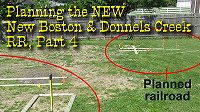 Return to "Planning the NEW New Boston and Donnels Creek, Part 4" -
Well, the rented post-hole digger fell through, so we dug our vegetable garden with a manual post-hole digger (the scissors kind). In addition, I stake out where the railroad was going to be. Twice. And tweaked the plans again. Sorry about the redo's, but sometimes just walking around the yard trying to visualize things makes me reconsider something that seemed "settled" only a few days before. Return to "Planning the NEW New Boston and Donnels Creek, Part 4" -
Well, the rented post-hole digger fell through, so we dug our vegetable garden with a manual post-hole digger (the scissors kind). In addition, I stake out where the railroad was going to be. Twice. And tweaked the plans again. Sorry about the redo's, but sometimes just walking around the yard trying to visualize things makes me reconsider something that seemed "settled" only a few days before.
Click on the photo to see what we were considering as of late May, 2017
 Return to "Planning the NEW New Boston and Donnels Creek, Part 3" -
We have still not broken ground. In part because we plan to rent a post-hole digger and dig the post holes for our raised vegetable garden and the first phase of the garden railroad at the same time, and we don't have enough lumber on hand yet. (If we didn't break it down into multiple trips, we'd be blowing out the shocks on our minivan.) In the meantime, we used a line level to see if the slope of the back yard was as bad as we thought it was (it's worse), and we did other site preparation, including planting a whole bunch of spruce tree seedlings to eventually give us some privacy in our side and back yard. Plus, I'm still wavering a little on the "where-to-start-first" issue. Return to "Planning the NEW New Boston and Donnels Creek, Part 3" -
We have still not broken ground. In part because we plan to rent a post-hole digger and dig the post holes for our raised vegetable garden and the first phase of the garden railroad at the same time, and we don't have enough lumber on hand yet. (If we didn't break it down into multiple trips, we'd be blowing out the shocks on our minivan.) In the meantime, we used a line level to see if the slope of the back yard was as bad as we thought it was (it's worse), and we did other site preparation, including planting a whole bunch of spruce tree seedlings to eventually give us some privacy in our side and back yard. Plus, I'm still wavering a little on the "where-to-start-first" issue.
Click on the photo to see what we were considering as of late April, 2017
 Return to "Planning the NEW New Boston and Donnels Creek, Part 2" -
More plans. We've moved on from the 2"x6" roadbed-on-posts to a sort of "train-table-outside" plan. Our goals include low-maintenance, high interest, and high reliability. We're also trying to get around having a thousand dollars' worth of dirt hauled into the back yard. If you want to get some idea of what our planning process looks like, reading these through in sequence may help. Or it may drive you crazy. Return to "Planning the NEW New Boston and Donnels Creek, Part 2" -
More plans. We've moved on from the 2"x6" roadbed-on-posts to a sort of "train-table-outside" plan. Our goals include low-maintenance, high interest, and high reliability. We're also trying to get around having a thousand dollars' worth of dirt hauled into the back yard. If you want to get some idea of what our planning process looks like, reading these through in sequence may help. Or it may drive you crazy.
Click on the photo to see what we were considering in early April, 2017
 Return to "Planning the NEW New Boston and Donnels Creek, Part 1" -
If you're subscribed to our newsletter, you know that we moved just after Thanksgiving in 2016, leaving behind most of the track, a few of the bird feeders, and one Bachmann train set for the new owners. We also left behind a high-maintenance garden that we do not intend to replicate at the new place. This is the first chapter of a new chapter in our lives, which we hope will include a lot of "lessons learned." But first, some serious landscaping had to take place. Return to "Planning the NEW New Boston and Donnels Creek, Part 1" -
If you're subscribed to our newsletter, you know that we moved just after Thanksgiving in 2016, leaving behind most of the track, a few of the bird feeders, and one Bachmann train set for the new owners. We also left behind a high-maintenance garden that we do not intend to replicate at the new place. This is the first chapter of a new chapter in our lives, which we hope will include a lot of "lessons learned." But first, some serious landscaping had to take place.
Click on the photo to see what we were considering in March, 2017
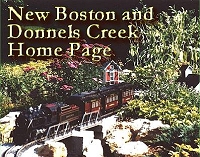 Return to the New Boston and Donnels Creek RR Page - This is the page describing Paul Race's progress and frequent rework on his own garden railroad, started on a shoe-string budget in 1998, later expanded, and later refurbished several times as issues arose. Issues that Paul hopes to avoid by building the next iteration above ground. Return to the New Boston and Donnels Creek RR Page - This is the page describing Paul Race's progress and frequent rework on his own garden railroad, started on a shoe-string budget in 1998, later expanded, and later refurbished several times as issues arose. Issues that Paul hopes to avoid by building the next iteration above ground.
Click on the photo to see the home page of Paul's railroad.
 Return to Family Garden Trains' Home Page - The home page with links to all the other stuff, including design guidelines, construction techniques, structure tips, free graphics, and more. Return to Family Garden Trains' Home Page - The home page with links to all the other stuff, including design guidelines, construction techniques, structure tips, free graphics, and more.
To read more, or to look at recommended Garden Railroading and Big Indoor Train products, please click on the index pages below.
| 
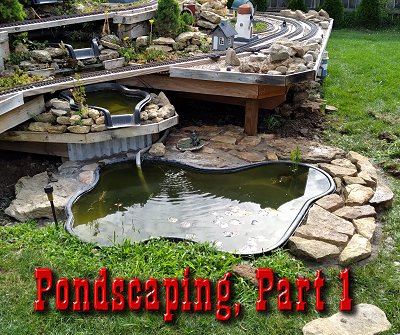














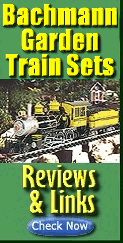























































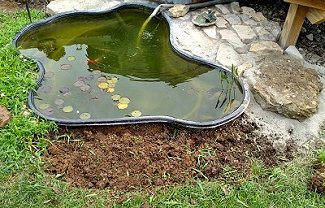

 Proceed to "Pondscaping, Part 2"
Proceed to "Pondscaping, Part 2" Return to "Easy Lighting for North States Bird Feeders"
Return to "Easy Lighting for North States Bird Feeders" Return to "Preparing for 2021's Christmas Train Day."
Return to "Preparing for 2021's Christmas Train Day." Return to "Making a Large Scale Ghost Train"
Return to "Making a Large Scale Ghost Train" Return to "Portal Installation on the New Boston and Donnels Creek."
Return to "Portal Installation on the New Boston and Donnels Creek."  Return to "Dirtscaping on the New Boston and Donnels Creek, Part 3"
Return to "Dirtscaping on the New Boston and Donnels Creek, Part 3" Return to "Tunnel Framing on the New Boston and Donnels Creek, Part 2"
Return to "Tunnel Framing on the New Boston and Donnels Creek, Part 2" Return to "Tunnel Framing on the New Boston and Donnels Creek, Part 1."
Return to "Tunnel Framing on the New Boston and Donnels Creek, Part 1."  Return to "New Right-of-Ways on the New Boston and Donnels Creek RR"
Return to "New Right-of-Ways on the New Boston and Donnels Creek RR" Return to "Creating a Railroad Timetable"
Return to "Creating a Railroad Timetable" Return to "Christmas Preparations and Operations 2020"
Return to "Christmas Preparations and Operations 2020" Return to "Garage to Train Station, Part 2"
Return to "Garage to Train Station, Part 2" Return to "Garage to Train Station, Part 1"
Return to "Garage to Train Station, Part 1" Return to "Westward Expansion, 2020, Part 3"
Return to "Westward Expansion, 2020, Part 3" Return to "Westward Expansion, 2020, Part 2"
Return to "Westward Expansion, 2020, Part 2" Return to "Westward Expansion, 2020, Part 1"
Return to "Westward Expansion, 2020, Part 1" Return to "Train Storage Solutions, 2020"
Return to "Train Storage Solutions, 2020" Return to "Expansion Planning, 2020"
Return to "Expansion Planning, 2020" Return to "Winter Preparation, 2019"
Return to "Winter Preparation, 2019" Return to "Christmas Train Day, 2019"
Return to "Christmas Train Day, 2019" Return to "Preparing for Christmas Train Day 2019"
Return to "Preparing for Christmas Train Day 2019" Return to Decking the NEW New Boston and Donnels Creek Part 2
Return to Decking the NEW New Boston and Donnels Creek Part 2 Return to "Framing the NEW New Boston and Donnels Creek RR - Part 7"
Return to "Framing the NEW New Boston and Donnels Creek RR - Part 7" Return to "Planning the NEW New Boston and Donnels Creek RR - Part 5"
Return to "Planning the NEW New Boston and Donnels Creek RR - Part 5" Return to Waterscaping Part 4.
Return to Waterscaping Part 4. Return to "Waterscaping, Part 3"
Return to "Waterscaping, Part 3" Return to Christmas Train Day, 2018
Return to Christmas Train Day, 2018 Return to "Adding a Train Shed Part 6"
Return to "Adding a Train Shed Part 6" Return to "Adding a Train Shed Part 5"
Return to "Adding a Train Shed Part 5" Return to "Adding a Train Shed Part 4"
Return to "Adding a Train Shed Part 4" Return to "Adding a Train Shed Part 3"
Return to "Adding a Train Shed Part 3" Return to "Waterscaping Part 2"
Return to "Waterscaping Part 2" Return to "Adding a Train Shed Part 2"
Return to "Adding a Train Shed Part 2" Return to "Adding a Train Shed Part 1"
Return to "Adding a Train Shed Part 1" Return to "Waterscaping the NEW New Boston and Donnels Creek Part 1,"
Return to "Waterscaping the NEW New Boston and Donnels Creek Part 1,"  Return to "Dirtscaping the NEW New Boston and Donnels Creek RR, Part 2.
Return to "Dirtscaping the NEW New Boston and Donnels Creek RR, Part 2. Return to "Adding Raised Roadbed to the NEW New Boston and Donnels Creek, Part 2"
Return to "Adding Raised Roadbed to the NEW New Boston and Donnels Creek, Part 2" Return to "Adding Raised Roadbed to the NEW New Boston and Donnels Creek RR, Part 1"
Return to "Adding Raised Roadbed to the NEW New Boston and Donnels Creek RR, Part 1" Return to "2018: Springing into Spring on the NEW New Boston & Donnels Creek RR."
Return to "2018: Springing into Spring on the NEW New Boston & Donnels Creek RR." Return to "Dirtscaping the NEW New Boston and Donnels Creek RR, Part 1.
Return to "Dirtscaping the NEW New Boston and Donnels Creek RR, Part 1. Return to "Decking the NEW New Boston and Donnels Creek RR
Return to "Decking the NEW New Boston and Donnels Creek RR Return to "Framing the NEW New Boston and Donnels Creek RR, Part 6"
Return to "Framing the NEW New Boston and Donnels Creek RR, Part 6" Return to "Framing the NEW New Boston and Donnels Creek RR, Part 5"
Return to "Framing the NEW New Boston and Donnels Creek RR, Part 5" Return to "Framing the NEW New Boston and Donnels Creek RR, Part 4"
Return to "Framing the NEW New Boston and Donnels Creek RR, Part 4" Return to "Framing the NEW New Boston and Donnels Creek RR, Part 3"
Return to "Framing the NEW New Boston and Donnels Creek RR, Part 3" Return to "Framing the NEW New Boston and Donnels Creek RR, Part 2"
Return to "Framing the NEW New Boston and Donnels Creek RR, Part 2" Return to "Framing the NEW New Boston and Donnels Creek RR, Part 1"
Return to "Framing the NEW New Boston and Donnels Creek RR, Part 1" Return to "Breaking Ground on the NEW New Boston and Donnels Creek"
Return to "Breaking Ground on the NEW New Boston and Donnels Creek" Return to "Planning the NEW New Boston and Donnels Creek, Part 4"
Return to "Planning the NEW New Boston and Donnels Creek, Part 4" Return to "Planning the NEW New Boston and Donnels Creek, Part 3"
Return to "Planning the NEW New Boston and Donnels Creek, Part 3" Return to "Planning the NEW New Boston and Donnels Creek, Part 2"
Return to "Planning the NEW New Boston and Donnels Creek, Part 2" Return to "Planning the NEW New Boston and Donnels Creek, Part 1"
Return to "Planning the NEW New Boston and Donnels Creek, Part 1" Return to the New Boston and Donnels Creek RR Page
Return to the New Boston and Donnels Creek RR Page Return to Family Garden Trains' Home Page
Return to Family Garden Trains' Home Page